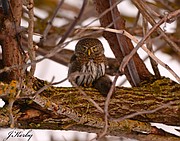The northern pygmy-owl: What a little hoot!
“The wailing owl screams solitary to the mournful moon.” — David Mallet
“Owls have been portrayed as symbols of war and feared by the superstitious as harbingers of tragedy and death. They also have been regarded with affection, even awe. In Greek mythology, an owl was associated with Athena, the goddess of wisdom, the Arts, and skills. As a result, owls became symbols of teaching and of institutions of higher learning.” — From Owls of Idaho
At seven inches long, the northern pygmy-owl is the smallest owl species in Idaho and is a forests bird that ranges west of the Rocky Mountains from British Columbia south to Central America. Despite its size (or because of it!), the north pygmy-owl is one of the boldest and fiercest of owls. Unlike most owls, which hunt by night and prey mainly on meadow voles, mice and other small mammals, the northern pygmy-owl hunts by day, and roughly 40 percent of its diet is composed of birds.
The plumb little owl attacks from a perch and grabs its prey with talons, using its beak to snap the neck. The pygmy-owls are fierce little birds that will attack prey much larger than themselves, even as large as a meadowlark. Pygmy-owls are found at elevations of 3,000 to 10,000 feet in forested areas adjacent to openings such as meadows or wetlands.
The northern pygmy-owl (Glaucidium gnoma; meaning glaring and having dwarf-like features) is only slightly larger than a soda can from head to tail. The feisty owl weighs just 2-3 ounces, with females running slightly larger than males. The northern pygmy-owl is mostly gray or brown with white spots on its round head. The back and wings have dark vertical marks streaking the light-colored belly.
On the back of the bird’s head is a pair of dark, oval spots that look like large eyes. One theory is that the northern pygmy-owl’s eyespots reduce predation. Another theory is that they reduce mobbing by prey birds. Because northern pygmy-owls hunt birds during daylight, the raptors are constantly attacked from behind by flocks of their prey. Eyespots might have evolved so the owls wouldn’t get attacked in the back of the head.
Northern pygmy-owls nest in dead tree cavities with a diameter of approximately 2.5 inches. Holes of this size are made when branches fall off or by small woodpeckers. Breeding begins in April, when males vocalize from the nesting hole with a toot—pause—too call. The song is a dove-like cooing or a wooden knocking sound that can continue for hours and is audible up to a mile away. When a female responds, he finds her and they mate. The male hunts while the female incubates the three to eight eggs. Owlets fledge (leaves the nest) after approximately 30 days and become fully independent 20 or 30 days later.
While watching from your window this winter, if you see that the chickadees scatter from your bird feeder in the middle of the day, it just could be that you have a pygmy owl visitor in the vicinity.
Enjoy beautiful Boundary County and its fascinating wildlife.



